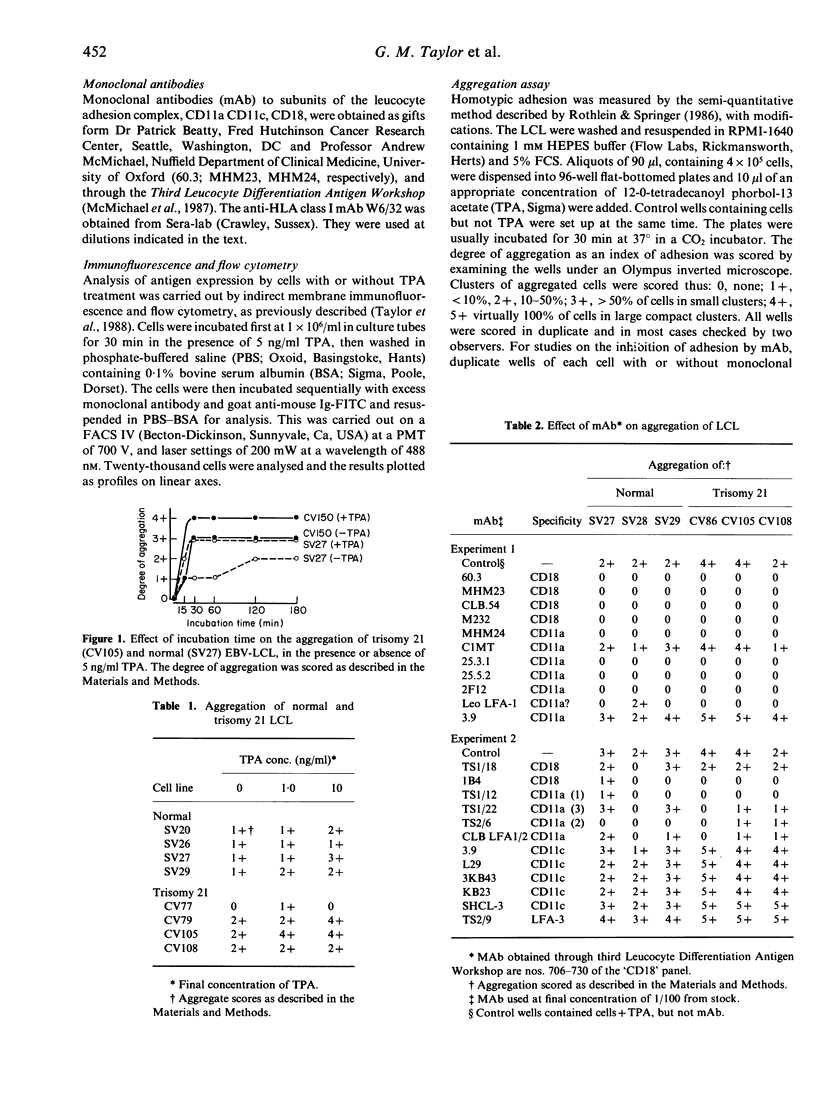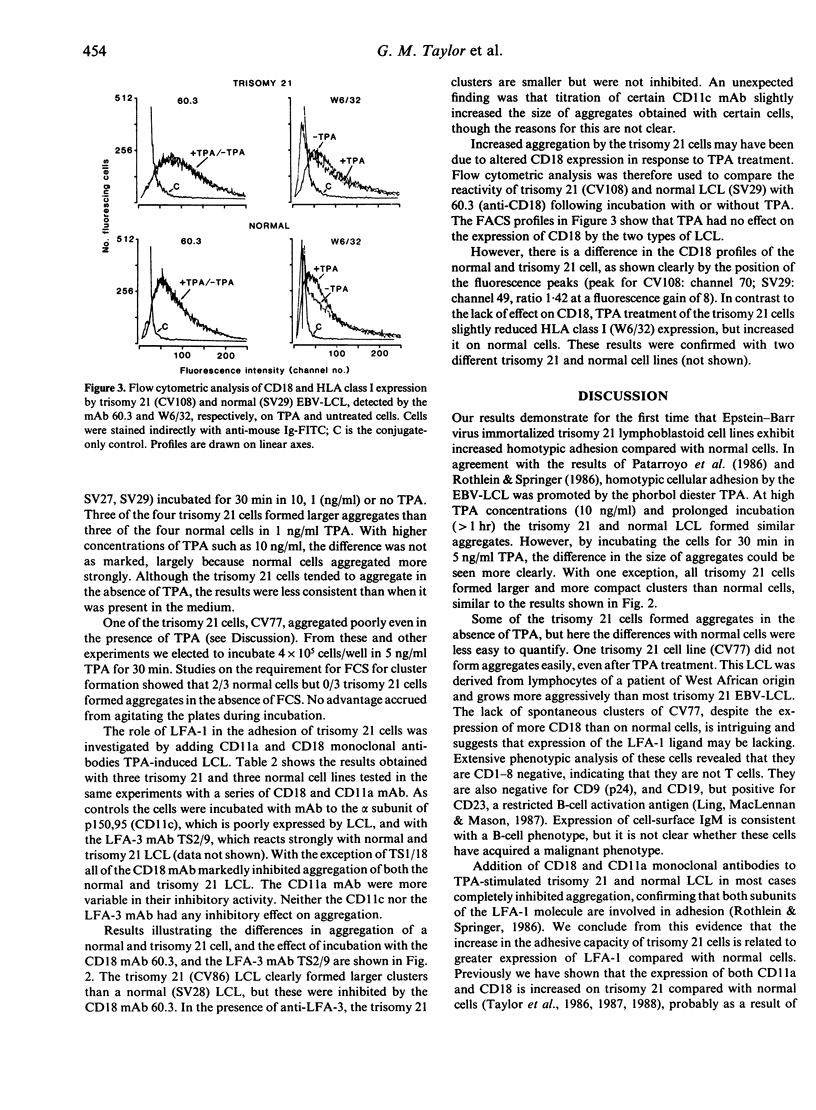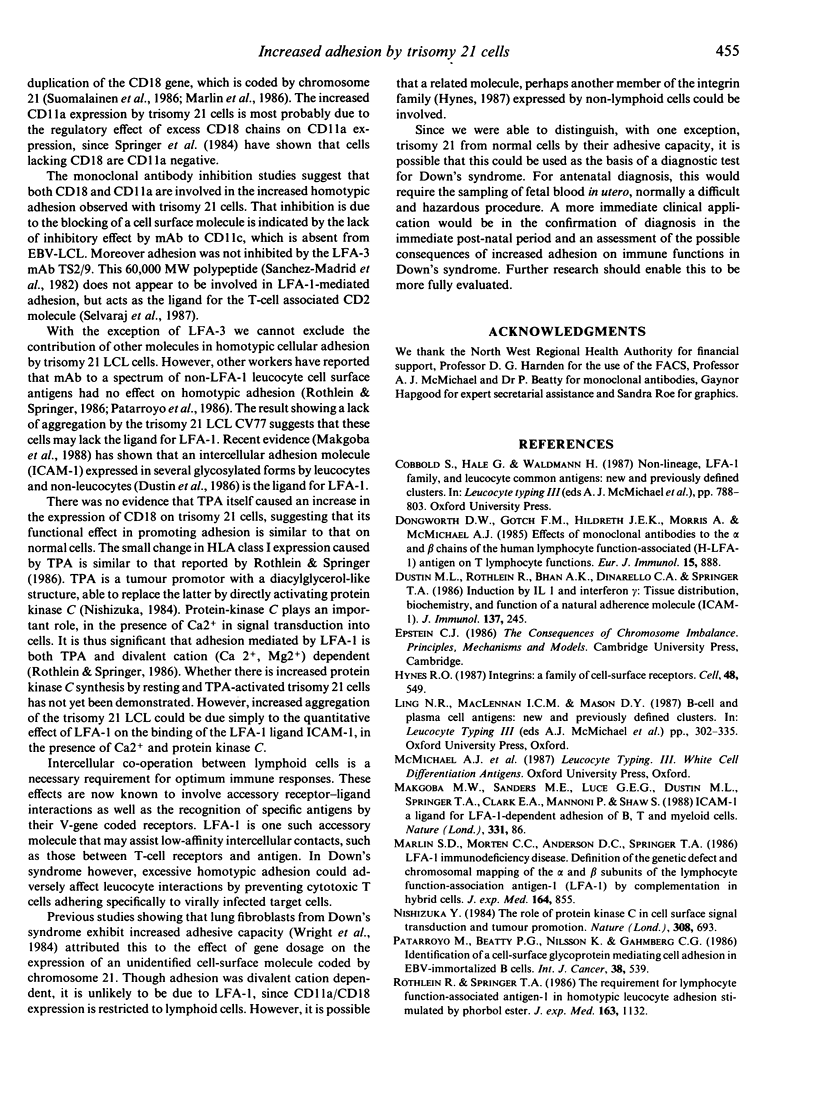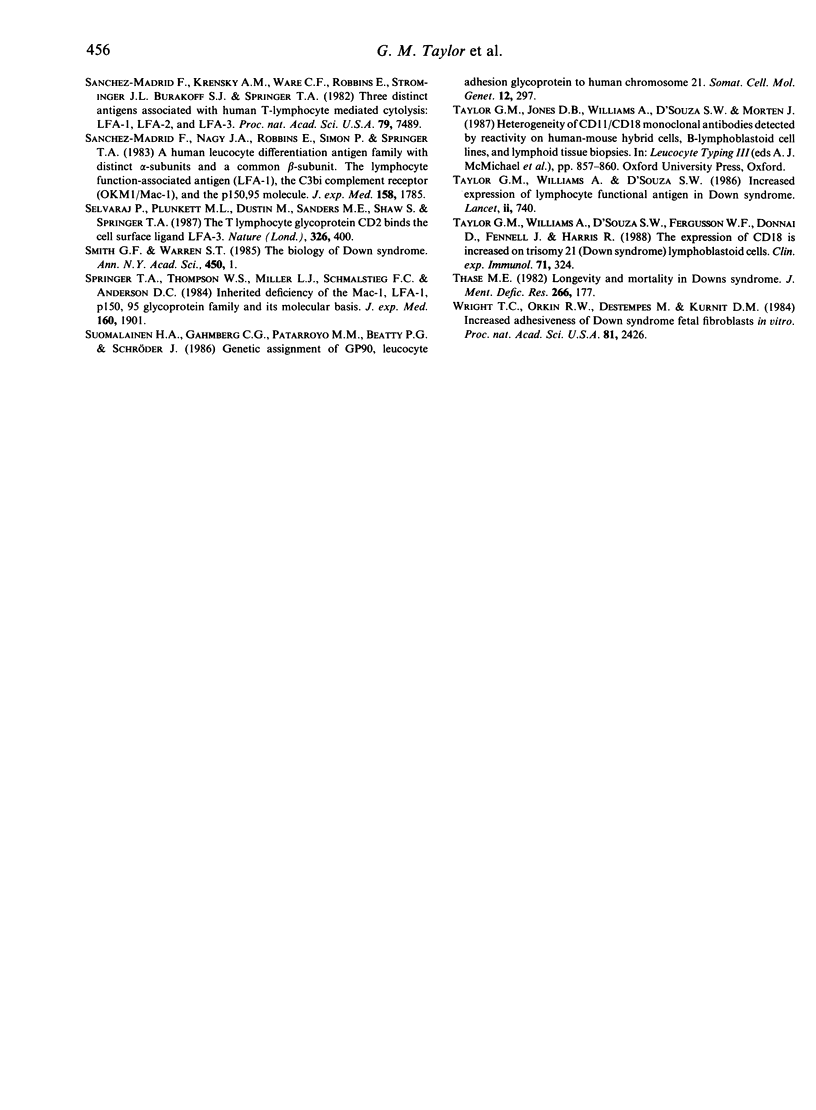Abstract
We have analysed homotypic adhesion induced by the phorbol ester TPA in EBV-immortalized Down's syndrome (trisomy 21) and normal lymphoblastoid cell lines. Our results show that the trisomy 21 cells aggregated more readily than normal cells. The aggregation of the two types of cell was blocked effectively by the addition of monoclonal antibodies to the alpha and beta chains (CD11a, CD18) of lymphocyte function-associated antigen (LFA-), but not by monoclonal antibodies to LFA-3 and the alpha chain of p150,95 (CD11c). Since TPA did not increase the expression of CD18 on trisomy 21 cells, we conclude that the increased adhesiveness is the result of over-expression of CD18 as a result of gene dosage.
Full text
PDF





Images in this article
Selected References
These references are in PubMed. This may not be the complete list of references from this article.
- Dongworth D. W., Gotch F. M., Hildreth J. E., Morris A., McMichael A. J. Effects of monoclonal antibodies to the alpha and beta chains of the human lymphocyte function-associated (H-LFA-1) antigen on T lymphocyte functions. Eur J Immunol. 1985 Sep;15(9):888–892. doi: 10.1002/eji.1830150905. [DOI] [PubMed] [Google Scholar]
- Dustin M. L., Rothlein R., Bhan A. K., Dinarello C. A., Springer T. A. Induction by IL 1 and interferon-gamma: tissue distribution, biochemistry, and function of a natural adherence molecule (ICAM-1). J Immunol. 1986 Jul 1;137(1):245–254. [PubMed] [Google Scholar]
- Marlin S. D., Morton C. C., Anderson D. C., Springer T. A. LFA-1 immunodeficiency disease. Definition of the genetic defect and chromosomal mapping of alpha and beta subunits of the lymphocyte function-associated antigen 1 (LFA-1) by complementation in hybrid cells. J Exp Med. 1986 Sep 1;164(3):855–867. doi: 10.1084/jem.164.3.855. [DOI] [PMC free article] [PubMed] [Google Scholar]
- Nishizuka Y. The role of protein kinase C in cell surface signal transduction and tumour promotion. Nature. 1984 Apr 19;308(5961):693–698. doi: 10.1038/308693a0. [DOI] [PubMed] [Google Scholar]
- Patarroyo M., Beatty P. G., Nilsson K., Gahmberg C. G. Identification of a cell-surface glycoprotein mediating cell adhesion in EBV-immortalized normal B cells. Int J Cancer. 1986 Oct 15;38(4):539–547. doi: 10.1002/ijc.2910380414. [DOI] [PubMed] [Google Scholar]
- Rothlein R., Springer T. A. The requirement for lymphocyte function-associated antigen 1 in homotypic leukocyte adhesion stimulated by phorbol ester. J Exp Med. 1986 May 1;163(5):1132–1149. doi: 10.1084/jem.163.5.1132. [DOI] [PMC free article] [PubMed] [Google Scholar]
- Sanchez-Madrid F., Krensky A. M., Ware C. F., Robbins E., Strominger J. L., Burakoff S. J., Springer T. A. Three distinct antigens associated with human T-lymphocyte-mediated cytolysis: LFA-1, LFA-2, and LFA-3. Proc Natl Acad Sci U S A. 1982 Dec;79(23):7489–7493. doi: 10.1073/pnas.79.23.7489. [DOI] [PMC free article] [PubMed] [Google Scholar]
- Sanchez-Madrid F., Nagy J. A., Robbins E., Simon P., Springer T. A. A human leukocyte differentiation antigen family with distinct alpha-subunits and a common beta-subunit: the lymphocyte function-associated antigen (LFA-1), the C3bi complement receptor (OKM1/Mac-1), and the p150,95 molecule. J Exp Med. 1983 Dec 1;158(6):1785–1803. doi: 10.1084/jem.158.6.1785. [DOI] [PMC free article] [PubMed] [Google Scholar]
- Selvaraj P., Plunkett M. L., Dustin M., Sanders M. E., Shaw S., Springer T. A. The T lymphocyte glycoprotein CD2 binds the cell surface ligand LFA-3. 1987 Mar 26-Apr 1Nature. 326(6111):400–403. doi: 10.1038/326400a0. [DOI] [PubMed] [Google Scholar]
- Springer T. A., Thompson W. S., Miller L. J., Schmalstieg F. C., Anderson D. C. Inherited deficiency of the Mac-1, LFA-1, p150,95 glycoprotein family and its molecular basis. J Exp Med. 1984 Dec 1;160(6):1901–1918. doi: 10.1084/jem.160.6.1901. [DOI] [PMC free article] [PubMed] [Google Scholar]
- Suomalainen H. A., Gahmberg C. G., Patarroyo M., Beatty P. G., Schröder J. Genetic assignment of GP90, leukocyte adhesion glycoprotein to human chromosome 21. Somat Cell Mol Genet. 1986 May;12(3):297–302. doi: 10.1007/BF01570789. [DOI] [PubMed] [Google Scholar]
- Taylor G. M., Williams A., D'Souza S. W., Fergusson W. D., Donnai D., Fennell J., Harris R. The expression of CD18 is increased on Trisomy 21 (Down syndrome) lymphoblastoid cells. Clin Exp Immunol. 1988 Feb;71(2):324–328. [PMC free article] [PubMed] [Google Scholar]
- Taylor G. M., Williams A., D'Souza S. W. Increased expression of lymphocyte functional antigen in Down syndrome. Lancet. 1986 Sep 27;2(8509):740–740. doi: 10.1016/s0140-6736(86)90248-5. [DOI] [PubMed] [Google Scholar]
- Thase M. E. Longevity and mortality in Down's syndrome. J Ment Defic Res. 1982 Sep;26(Pt 3):177–192. doi: 10.1111/j.1365-2788.1982.tb00144.x. [DOI] [PubMed] [Google Scholar]
- Wright T. C., Orkin R. W., Destrempes M., Kurnit D. M. Increased adhesiveness of Down syndrome fetal fibroblasts in vitro. Proc Natl Acad Sci U S A. 1984 Apr;81(8):2426–2430. doi: 10.1073/pnas.81.8.2426. [DOI] [PMC free article] [PubMed] [Google Scholar]



